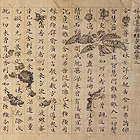Japanese Gallery (Honkan) Room T2
September 6, 2011 (Tue) - October 16, 2011 (Sun)
From ancient times, transcribing Buddhist sutras was considered a pious deed. Transcription of sutras was widely practiced in Japan ever since Buddhism was introduced in the Asuka period (593-710), regardless of social rank. In the Nara period (710-794), the government established an official department for sutra transcription to pray for the peace and security of the country. Under this department, large-scale national projects of sutra transcriptions were carried out by transcription experts. Many manuscripts from this time survive until now, including Kengu kyo (Sutra of the wise and foolish), also known as Ojomu, which has been attributed to Emperor Shomu (reigned 724-749) from the vigor of the calligraphy; and Gogatsutsuitachi kyo, which was transcribed under the auspices of Empress Komyo, consort of Emperor Shomu. Later in the Heian period (794-1192), court nobles as well as regional aristocracy began to dedicate sutra transcriptions, and it was in this time that many extravagantly decorated sutras were produced, reflecting the aesthetics of the nobles. The best known examples of these manuscript sutras include the Kunoji kyo, Chikubushima kyo, and Chusonji kyo.
To coincide with the publication of the Illustrated Catalogue of Tokyo National Museum: Manuscript Sutras, this exhibition presents masterpieces of manuscript sutras from the Nara through the Kamakura period, and looks into their beauty and the people’s devotion that took the form of sutras.

